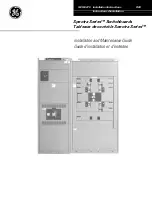
E-51
ENGLISH
Type and condition of
abnormality
Defect/Probable cause
Treatment
Investigation/Primary treatment
Secondary treatment
1. The circuit breaker
is not closed.
1. The closing operation cannot be
performed.
1.1 The OFF-lock device (CYL,
CAL, Padlock) is not
released.
Release the OFF-lock device.
(CYL, CAL, Padlock)
Please contact Mitsubishi Electric
if closing cannot be performed
even after completing the primary
treatment.
1.2 The circuit breaker is not in
the correct position.
Change the drawout position to
“CONNECT”, “DISCONNECT”, or
“TEST”.
1.3 The drawout handle is
inserted.
Pull out the drawout handle.
1.4 Voltage is not applied to the
UVT.
Apply voltage to the UVT.
Refer to the section “ 10.3.2
Opening” if there is an abnormality
of the UVT.
1.5 Voltage is not applied to
S1 and S2 of the
control circuit terminal.
Examine the circuit.
ー
2. The closing operation is
performed.
Tripping (OFF) is performed
simultaneously with the closing
operation.
Please contact Mitsubishi Electric.
ー
3. ON button is damaged or
cannot be pushed.
Please contact Mitsubishi Electric.
ー
4. Manual reset button protrudes.
Push the Manual reset button to
reset.
ー
5. The circuit breaker body greatly
tilts.
Check the installation conditions
on page 19 and install the circuit
breaker correctly.
ー
2. The circuit breaker
is not opened.
1. The contact does not open even
after pushing the OFF button.
Please contact Mitsubishi Electric.
(Note)
ー
2. The SHT does not operate.
1. If the voltage is not applied,
examine the control circuit.
ー
2. In the case of voltage applied,
the circuit breaker has some
failure. Please contact
Mitsubishi Electric.
ー
3. OFF button is damaged or
cannot be pushed.
Please contact Mitsubishi Electric.
ー
3. Unusual
temperature rise
1. Loosing of the main circuit
terminal screws.
Retighten. (M12 45±5 N·m)
Please contact Mitsubishi Electric
if discoloration of the conductor or
the terminal molding is noted.
2. Main circuit junction is
damaged.
Please contact Mitsubishi Electric.
ー
3. The contact resistance of the
contact has increased.
(DC resistance value is to be
the catalog value × 1.5 or less)
Clean the contact surface (by
using wire brush).
Please contact Mitsubishi Electric
if the temperature does not fall
even after cleaning the contact
surface.
4. Load current is too large.
Check the load equipments.
ー
4. Electronic Trip
Relay (ETR)
Abnormality
4.1 Unexpected trip
1. Trip at rated current or less
Check the load current and
characteristics setting of the ETR.
Check the characteristics by the
field test device Y-2005.
Please contact Mitsubishi Electric
if there are any abnormalities.
2. Trip when the load starts
Check the inrush current and STD/
INST setting of the ETR.
Please contact Mitsubishi Electric
if there are any abnormalities.
3. Trip due to noise or surge
Shift the setting of the ETR to
upper level (temporary use).
Check connection of the frame
ground terminal P4 .
Reduce noise or surge at the
source. Add a surge absorber, etc.
4.2 Abnormal
characteristics
1. The circuit breaker does not trip
even when an over current
flows.
Check the load current and
characteristics setting of the ETR.
Check the characteristics by the
field test device Y-2005.
Please contact Mitsubishi Electric
if there are any abnormalities.
2. The characteristics by the field
test device Y-2005 is
abnormality.
Check the field test device setting.
Please contact Mitsubishi Electric.
22.4 Fault Diagnosis
















































